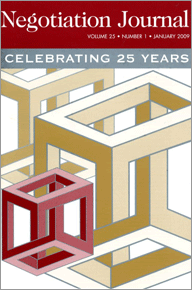
In the July 2011 issue of Negotiation Journal, mediator David Hoffman takes a thoughtful look at the role of caucusing in mediation in an article entitled “Mediation and the Art of Shuttle Diplomacy.” The practice of meeting separately with each disputant, while widespread, is not without controversy. Critics have argued that these private sessions give the mediator too much power at the expense of the parties and that joint sessions improve the parties’ understanding of each other.
But, Hoffman argues, caucusing provides mediators with an indispensable tool for addressing some of mediation’s stickiest dilemmas. Some parties, for a variety of reasons, will never be willing to speak freely in front of each other. In highly contentious, emotional disputes, frequent private meetings may be the only viable option.
Mediation practice is also the focus of an article in this issue by Neil Sargent, Cheryl Picard, and Marnie Jull entitled “Rethinking Conflict: Perspectives from the Insight Approach.” The authors argue that disputes result not only from a conflict between parties’ interests and goals, but also from a failure to understand each other’s “cares,” which include “our value-based expectations of others’ behavior as well as our assumptions of how people ought to act.” Understanding each other’s cares, the authors write, can reduce each party’s perceptions of threat and help them to develop better ways of dealing with each other.
In her article entitled “Ripening within? Strategies Used by Rebel Negotiators to End Ethnic War,” author Jannie Lilja compares conflicts in Sri Lanka, Indonesian Aceh, and Senegal in an effort to understand when and how bloody ethnic conflicts may become ripe for settlement. Specifically, Lilja examines what strategies rebels use to prepare their own communities for negotiated peace.
In the July issue’s review essay, Patrick Field casts a critical eye on John Forester’s book Dealing with Differences: Dramas of Mediating Public Disputes. Forester tells the stories of several different mediators working in the public arena, with a particular emphasis on how they have handled what some theorists have termed “deep-value conflicts.” Field finds these stories compelling and worthwhile but also wonders when we will begin to read of such mediations from the perspective of the disputants themselves.
Finally, in their article, negotiation teachers Terry Foster and Eric Farquharson describe the approach they have developed for solving the dilemma of how to evaluate the skills of student negotiators. The authors report that they have successfully adapted ROTC leadership training tools for application in negotiation classrooms. These include peer-to-peer assessment of precisely defined skills and traits, which helps not only the students who receive feedback but also the students who give it.
The Negotiation Journal is a multidisciplinary international journal devoted to the publication of works that advance the theory, analysis, practice, and instruction of negotiation and dispute resolution. For more information on the Negotiation Journal, visit our publications page.




